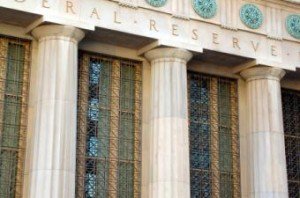 Wednesday afternoon, the Federal Reserve Board met and voted to keep rates near 0% at least through 2023, while upgrading their overall economic outlook.
Wednesday afternoon, the Federal Reserve Board met and voted to keep rates near 0% at least through 2023, while upgrading their overall economic outlook.
“The COVID-19 pandemic is causing tremendous human and economic hardship across the United States and around the world,” said the Board of Governors of the Federal Reserve in a post-meeting statement. “Following a moderation in the pace of the recovery, indicators of economic activity and employment have turned up recently, although the sectors most adversely affected by the pandemic remain weak. Inflation continues to run below 2%. Overall financial conditions remain accommodative, in part reflecting policy measures to support the economy and the flow of credit to U.S. households and businesses.”
The Fed met as the nation’s economy continues to point upward, with unemployment claims dropping by 42,000 last week and portions of the $1.9 trillion American Rescue Plan economic stimulus package—mainly $1,400 in individual stimulus payments—hitting bank accounts this week. These factors, combined with a rise in vaccination roll-outs and an easing of pandemic-mandated restrictions slowly lifting, could position the economy for a strong start this spring.
But the Fed still navigates this landscape with caution.
“The path of the economy will depend significantly on the course of the virus, including progress on vaccinations," said the Fed in a statement. “The ongoing public health crisis continues to weigh on economic activity, employment, and inflation and poses considerable risks to the economic outlook. The Federal Reserve is committed to using its full range of tools to support the U.S. economy in this challenging time, thereby promoting its maximum employment and price stability goals.”
“The Fed is now probing the unknown as a powerful trio of massive fiscal stimulus, monetary support, and pent-up demand impact an economy released by the widespread dissemination of vaccines,” said Economist Lynn Reaser of Point Loma Nazarene University in a recent Bloomberg feature.
The housing market continues to lead the charge, jolting the economy with strong numbers due to all-time-low mortgage rates. Standing at just a shade above the 3% mark, homebuyers are clamoring to a market that is short on supply and big on competition.
“In addition, the Federal Reserve will continue to increase its holdings of Treasury securities by at least $80 billion per month and of agency mortgage‑backed securities by at least $40 billion per month until substantial further progress has been made toward the Committee's maximum employment and price stability goals,” said Federal Reserve Chair Jerome H. Powell. “These asset purchases help foster smooth market functioning and accommodative financial conditions, thereby supporting the flow of credit to households and businesses.”
Realtor.com’s Housing Market Recovery Index—an analysis of new listings, buyer demand, time spent on the market and home prices—stood at 101.6 for the week ending March 6, 0.5 points higher than the previous week, and 1.6 points above pre-pandemic levels. Add a short supply of homes to the mix and the result is a tight market where many are paying well over the listing price to secure the home of their dreams.
The Fed estimates that price gains will rise to 2.1% by the end of 2023, the same time unemployment falls further and at a more rapid pace.

 DSNews The homepage of the servicing industry
DSNews The homepage of the servicing industry









